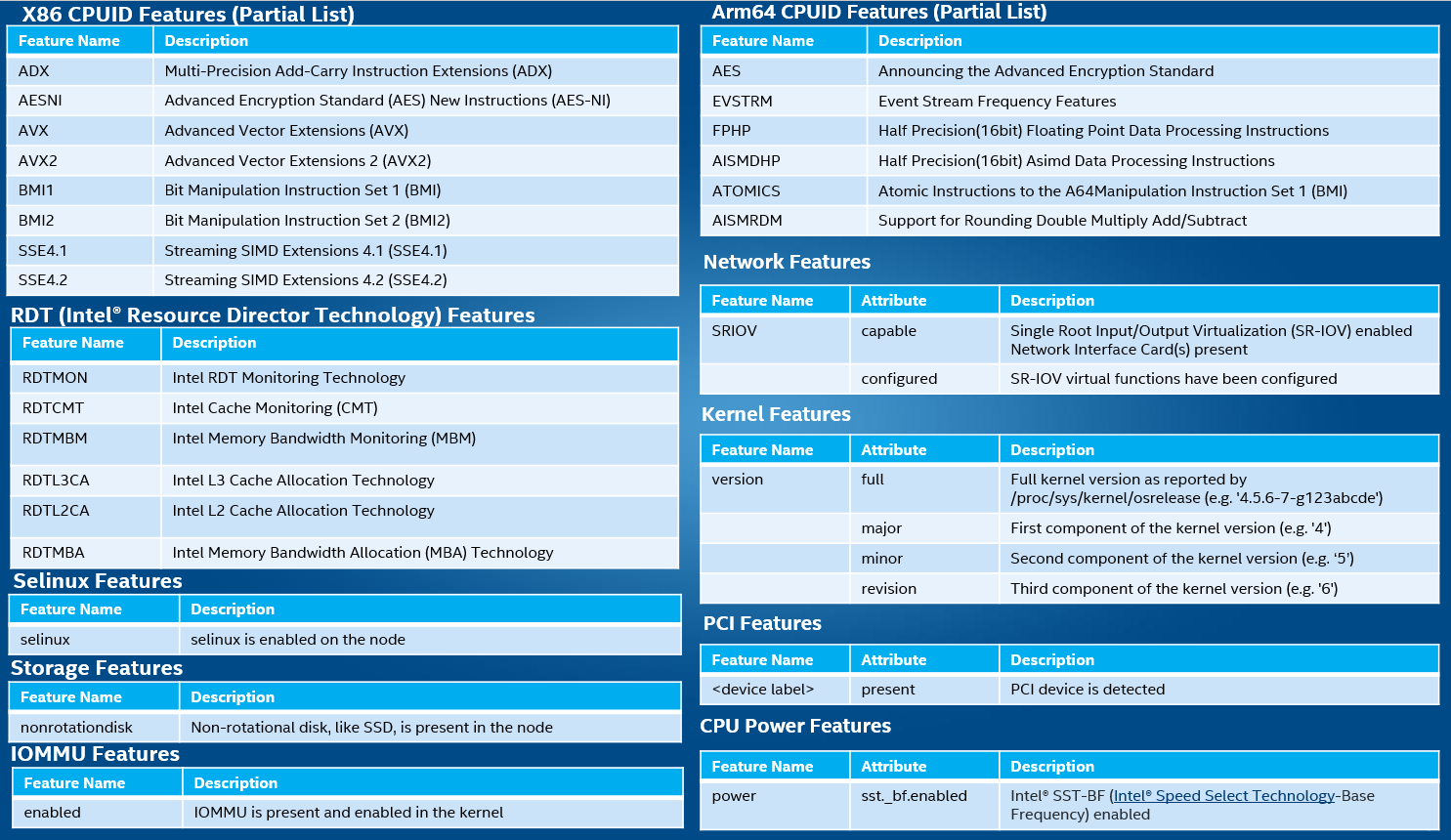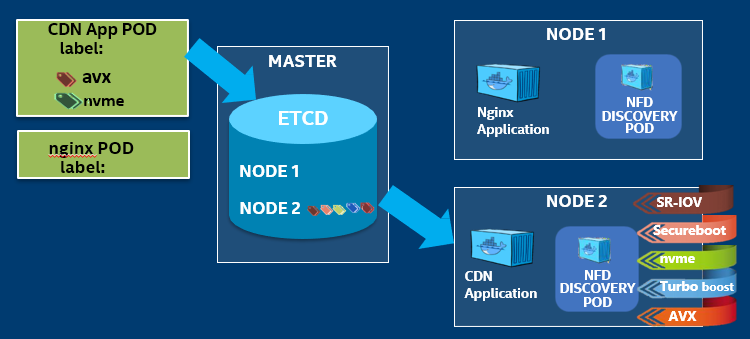SPDX-License-Identifier: Apache-2.0
Copyright (c) 2019 Intel Corporation
A newer version of this document exists.
This document applies to experience kits deployed using Ansible.
See the updated Node Feature Discovery documentation for kits that use the Edge Software Provisioner for deployment, such as the Developer Experience Kit.
Node Feature Discovery support in Smart Edge Open
Overview of NFD and Edge usecase
Commercial, off-the-shelf (COTS) platforms used for edge deployment come with many features that enable workloads to take advantage of, to provide better performance, and to meet the SLA. When such COTS platforms are deployed in a cluster as part of a cloud-native deployment, it becomes important to detect the hardware and software features on all nodes that are part of that cluster. It should also be noted that some of the nodes might have special accelerator hardware (FPGA, GPU, Non-Volatile Memory Express (NVMe)*, etc.).
Consider an edge application such as CDN that needs to be deployed in the cloud-native edge cloud. It is favorable for a container orchestrator like Kubernetes* to detect the nodes that have CDN-friendly hardware and software features (NVMe, media extensions, etc.).
Next, consider a Container Network Function (CNF) such as 5G gNb that implements L1 5G NR base station. It is favorable for the container orchestrator like Kubernetes to detect nodes that have hardware and software features—FPGA acceleration for Forward Error Correction (FEC), advanced vector instructions to implement math functions, real-time kernel, etc.
Smart Edge Open supports the discovery of such features using Node Feature Discovery (NFD). NFD is a Kubernetes add-on that detects and advertises hardware and software capabilities of a platform that can, in turn, be used to facilitate intelligent scheduling of a workload. NFD is one of the technologies from Intel that supports targeting of intelligent configuration and capacity consumption of platform capabilities. NFD runs as a separate container on each node of the cluster, discovers the capabilities of the node, and finally, publishes these as node labels using the Kubernetes API. NFD only handles non-allocatable features.
Some of the Node features that NFD can detect include:

 Figure - Sample NFD Features
Figure - Sample NFD Features
At its core, NFD detects hardware features available on each node in a Kubernetes cluster and advertises those features using node labels.
NFD consists of two software components: 1) nfd-master is responsible for labeling Kubernetes node objects 2) nfd-worker detects features and communicates them to the nfd-master. One instance of nfd-worker should be run on each node of the cluster
The figure below illustrates how the CDN application will be deployed on the correct platform when NFD is utilized, where the required key hardware like NVMe and the AVX instruction set support is available.

Figure - CDN app deployment with NFD Features
Non-Volatile Memory Express (NVMe)* is a scalable, non-volatile memory host interface that can help increase efficiency and reduce latency, while providing high-speed access to storage media connected over PCIe. NVMe overcomes SAS/SATA SSD performance limitations by optimizing hardware and software to take full advantage of NVM SSD technology.
AVX CPUID Features: Intel® Advanced Vector Extensions 512 (Intel® AVX-512)
UEFI Secure Boot: Boot Firmware verification and authorization of OS Loader/Kernel components
Details
Node Feature Discovery support in Smart Edge Open Network Edge
Node Feature Discovery is enabled by default. It does not require any configuration or user input. It can be disabled by changing the ne_nfd_enable variable to false in the inventory/default/group_vars/all/10-open.yml before the Smart Edge Open installation.
The connection between nfd-nodes and nfd-control-plane is secured by certificates generated before running NFD pods.
Node Feature Discovery is deployed in Smart Edge Open using a Helm chart downloaded from container-experience-kits repository.
Usage
NFD is working automatically and does not require any user action to collect the features from nodes. Features found by NFD and labeled in Kubernetes can be shown by the following command:
kubectl get no -o json | jq '.items[].metadata.labels'
Example output :
{
"beta.kubernetes.io/arch": "amd64",
"beta.kubernetes.io/os": "linux",
"feature.node.kubernetes.io/cpu-cpuid.ADX": "true",
"feature.node.kubernetes.io/cpu-cpuid.AESNI": "true",
"feature.node.kubernetes.io/cpu-cpuid.AVX": "true",
"feature.node.kubernetes.io/cpu-cpuid.AVX2": "true",
"feature.node.kubernetes.io/cpu-cpuid.FMA3": "true",
"feature.node.kubernetes.io/cpu-cpuid.HLE": "true",
"feature.node.kubernetes.io/cpu-cpuid.RTM": "true",
"feature.node.kubernetes.io/cpu-rdt.RDTCMT": "true",
"feature.node.kubernetes.io/cpu-rdt.RDTL3CA": "true",
"feature.node.kubernetes.io/cpu-rdt.RDTMBM": "true",
"feature.node.kubernetes.io/cpu-rdt.RDTMON": "true",
"feature.node.kubernetes.io/iommu-enabled": "true",
"feature.node.kubernetes.io/kernel-config.NO_HZ": "true",
"feature.node.kubernetes.io/kernel-config.NO_HZ_FULL": "true",
"feature.node.kubernetes.io/kernel-config.PREEMPT": "true",
"feature.node.kubernetes.io/kernel-version.full": "3.10.0-957.21.3.rt56.935.el7.x86_64",
"feature.node.kubernetes.io/kernel-version.major": "3",
"feature.node.kubernetes.io/kernel-version.minor": "10",
"feature.node.kubernetes.io/kernel-version.revision": "0",
"feature.node.kubernetes.io/memory-numa": "true",
"feature.node.kubernetes.io/network-sriov.capable": "true",
"feature.node.kubernetes.io/pci-0300_102b.present": "true",
"feature.node.kubernetes.io/system-os_release.ID": "centos",
"feature.node.kubernetes.io/system-os_release.VERSION_ID": "7",
"feature.node.kubernetes.io/system-os_release.VERSION_ID.major": "7",
"feature.node.kubernetes.io/system-os_release.VERSION_ID.minor": "",
"kubernetes.io/arch": "amd64",
"kubernetes.io/hostname": "edgenode-kubeovn",
"kubernetes.io/os": "linux",
"node-role.kubernetes.io/worker": "worker"
}
To specify which features should be available by the node at deploying pod time, the nodeSelector field should be defined in the pod .yaml file. Example pod yaml file:
apiVersion: v1
kind: Pod
metadata:
labels:
env: test
name: golang-test
spec:
containers:
- image: golang
name: go1
nodeSelector:
feature.node.kubernetes.io/cpu-pstate.turbo: 'true'
Reference
More details about NFD can be found here: https://github.com/Intel-Corp/node-feature-discovery